The Physics Of Figure Skating
12:17 minutes
While oohing and ahhing at the powerful leaps and nimble spins on the ice at the Olympics, you may not realize you’re watching physics in action. Each jump requires a careful balance of matching the time in air to the speed and number of rotations. Deborah King, exercise and sport science professor at Ithaca College, helps us deconstruct a figure skating jump through a physics perspective. Here’s what’s going on.
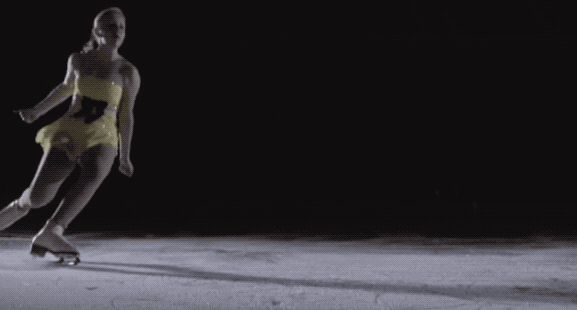
As a skater preps for a leap, they build up angular momentum. This helps drive a skater’s spins, and can be thought of as spin potential. A number of factors go into that potential: the skater’s starting position, how that position changes during takeoff, and the force that they create against the ice as they leave the surface. “Essentially, as they’re coming off the ice and they’re pushing down to get their vertical velocity, they also need to push against the ice more sideways, so they can start turning on the ice, and to get some rotational momentum,” says King in a phone call with Science Friday. And then—voila!—the skater is rising in the air.
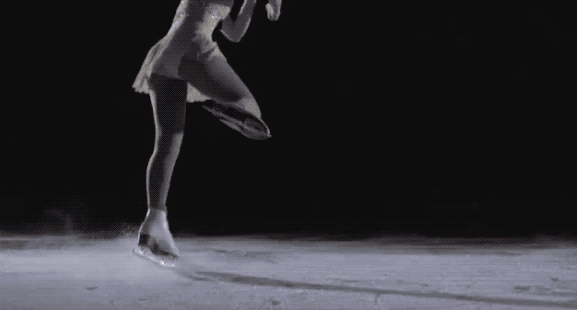
King estimates that professional female skaters often leap about 16 inches off the ice, while males reach about 20 inches. But the ability to jump high comes with a trade-off. In order to increase jump height, a skater must increase their strength. But an increase in strength often means an increase in muscle weight—which could mean a slower rotational speed.
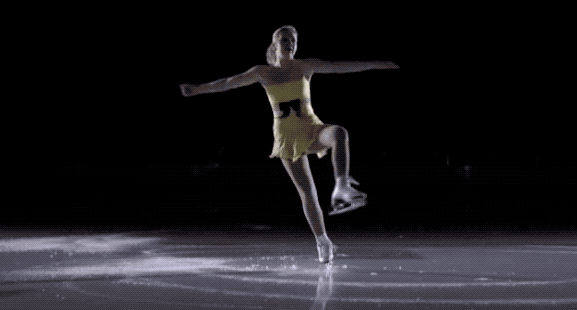
Once a skater leaps into the air, they’re stuck with however much angular momentum they’ve created. But a skater can change one thing: the moment of inertia. Moment of inertia determines how easy it is for an object to speed up or slow down, and describes the resistance that a force is working against. A larger moment of inertia—like when a skater extends their arms—will result in a slower rotational speed. But a smaller moment of inertia—like when a skater hugs their arms into their body tightly—will lead to a faster spin.
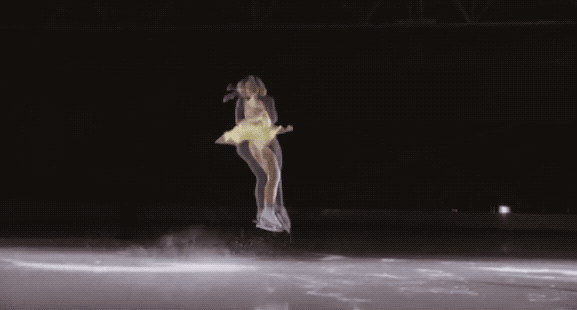
Skaters aren’t in the clear once they complete their rotations. They still must land those leaps, but that’s no easy feat. Some estimate that skaters impact the ice with a force five to eight times their body weight. That means that Olympic skater Nathan Chen, who weighs 135 pounds, could be hitting the ice with over half a ton of weight. Skaters must dissipate the majority of their energy in their landing, which takes place over a very small time period.
“It would be like slamming on your brakes to come to a stop at 60 miles per hour,” explains King. “They come to a stop very quickly, so that takes a lot of force.”
Why do they stop so quickly? For one thing, the blade and the skating boot are rigid, which strips skaters of some of the flexibility in the foot and ankle. They can’t spread the dissipation of energy over a longer time period and over a bigger range of motion, like a volleyball player who lands with bent ankles, knees, and hips. Plus, the rigid blade is coming down on a concrete floor that’s covered with ice.
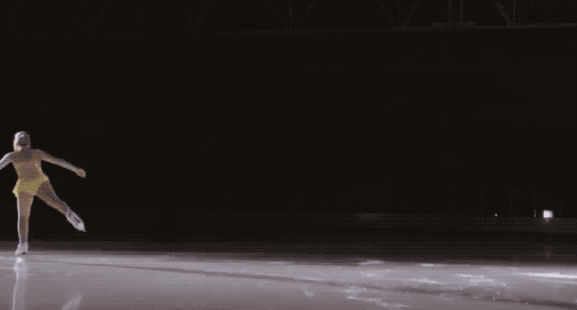
King joins Ira to discuss the physics of figure skating. She’s joined by David Wang, clinical director of Elite Sports Medicine at Connecticut Children’s Medical Center, who discusses how all that spinning affects skaters’ brains.
Deborah King is a professor in the Department of Exercise and Sport Sciences at Ithaca College.
David Wang, MD, is the clinical director of elite sports medicine at Connecticut Children’s Medical Center in Farmington, Connecticut.
IRA FLATOW: This is Science Friday, I’m Ira Flatow. A bit later in the hour, common household products causing outdoor air pollution, but first, it is impossible to watch the performances in the Winter Olympic Games. The back to back 1440, he’s on the snowboarding halfpipe. The quadruple lutz’s, and layback, and camel spins on the skating ice, without wondering, how the heck did they do that?
Well naturally, being a science show, our first instinct was to call an expert in biomechanics to talk Olympic laws of motion. Deborah King is that expert. She’s professor at the Department of Exercise and Sports Sciences at Ithaca College in New York. Welcome to Science Friday.
DEBORAH KING: Thank you.
IRA FLATOW: Let me tell my listeners that they’ve seen a stunt that they want you to decode. Give us a call, 8-4-4- 7- 2-4- 8-2- 5-5. 8- 4- 4– side talk, or tweet us @scifri. Dr. King, have you been watching a lot of the skating, or like what event you like the most?
DEBORAH KING: Oh, that’s a tough call. I like them all. I watch a lot of alpine skiing, I watched the figure skating. I love the bobsled skeleton and luge, ski jumping, aerial snowboard, you name it. Snow, ice, gravity, it’s all fun.
IRA FLATOW: You do live up there where it’s kind of snowy in Ithaca. I can’t imagine why you do that. All right, let’s go to the skate jump. Skate jumps, OK, from a physics perspective, what’s happening in those fancy skate jumps?
DEBORAH KING: Sure, there’s a lot going on in a very short period of time. The jumps take less than a second, and the skaters need to go off the ice, jump up in the air, they jump about two feet in air if you’re watching the guys do their quad lutz’s.
They spin around, they can easily reach rotation speeds above six revolutions per second, and then they need to land without falling. So there’s a lot of physics going on in the projectile motion and conservation of angular momentum that sort of govern what they can do in the air.
IRA FLATOW: So it’s a trade off, because if you want to spin and you want to jump high, you suck off some of the energy from each motion. You have to decide how much, right?
DEBORAH KING: Absolutely, so they’re coming into the takeoff and they need to push off the ice, and if they put all their effort into jumping really high, they’re not going to get that angular momentum or rotational resource to spin fast in the air.
Or if they really crank it around and go for spinning really fast, they might not push hard enough and go high. And it’s going to be a balancing act, because when it comes down to it, they need to finish their four revolutions right when their foot’s contacting the ground so they can glide out and skate into the next skill.
IRA FLATOW: Why do we see a difference in the number of spins the men and women skaters can pull off.
DEBORAH KING: Sure, a lot of that is going to have to do with body size. So the women tend to be smaller. They generally aren’t going to jump as high on average. They can be some women who jump higher, but on average, if they’re not jumping as high, they’re not in the air as long.
So they would have to spin a whole lot faster than the guys would to get around four revolutions. And while they’re smaller, it’s a little easier for them to spin fast, but that spin initiates when they’re on the ice. So when they come off the ice, if they don’t have more angular momentum off the ice, their body size is not going to get them spinning enough faster to make up that four revolutions. So generally it’s really going to come down to their size levels.
IRA FLATOW: And you talk about angular momentum. That is so important here, tell me, what is that?
DEBORAH KING: That’s a great question. So angular momentum is your potential to rotate. It’s sort of like a rotational resource. So it’s something you have to push against something to get some momentum to rotate. And then once they’re in the air, they can no longer push against the ice. They’re stuck with the amount of angular momentum they have.
So they only have a certain amount of potential to rotate. But what’s really cool is even though they have a set amount of momentum, they can still rotate faster if they want to. And they do that by changing their body size.
IRA FLATOW: So they pull their arms in when they want to go faster?
DEBORAH KING: Exactly. The same thing you see them do on the ice, where they start with their arms sort of wide, they get a push off the ice, their arms are really wide out from their body, and they pull them in and they go really fast– they do that in the air too.
When they come off the ice, their arm’s a little more out from their body, so is the leg that they’re not jumping off of, and then they snap into that rotating position right when they get in the air and the rotation speed speeds up really fast. And they hold that all the way before they land.
IRA FLATOW: So knowing that little bit we know about physics, compare snowboarding to ice skating. Are there any similarities in the physics going on there?
DEBORAH KING: Absolutely, there’s a lot of similarity. They get their vertical velocity for going up in the air differently, they don’t have to push off the flat surface. But they need to build up speed, if we’re talking about the half pipe, coming down one side or the half pipe, crossing over the bottom the half pipe, and going up the other– that’s where they get their speed.
And that speed they come off the lip or the rim of the half pipe with will determine how high they go. The higher they go, the longer they’re in the air, the more rotations they can do. And the other thing you see them do right before they come off the rim or the lip, you’ll see they’ve turned their upper body as they’re creating a torque against the ice or the snow, and that’s giving them the angular momentum.
So then once they’re up in the air, you see them do the same types of things. They move their body position so they can rotate around and get their 1440 done, or 1080, whichever skill they’re doing.
IRA FLATOW: Oh, they can do it and we can’t, I can’t.
DEBORAH KING: Exactly.
IRA FLATOW: It’s why I’m sitting here and there over there. I’d like to bring on another guest now to talk about some of the forces on the skater’s bodies, and the way blood is forced through the bodies as they do some of these performances. David Wang, clinical director of Elite Sports Medicine at Connecticut Children’s Medical Center. Welcome to Science Friday.
DAVID WANG: Hello, how are you doing?
IRA FLATOW: Now I know that you’ve studied the forces involved in figure skater’s spinning. Does a spin subject the skater’s brain to a lot of g-forces?
DAVID WANG: Well, it certainly does. The whole body is subject to the forces. And it depends on the position that’s been, but yes, there are certain spins such as a layback spin where a significant amount of force is sort of felt by the head. And as you mentioned before, we have the forces plus we have blood moving through the vessels and being centrifuged out to create a multitude of symptoms.
IRA FLATOW: Mhm. Is it dangerous moving all of that blood and all the forces around in the head?
DAVID WANG: Well, typically not. I think that anything done in an extreme of course can cause some problems. If you are to look at the figure skaters when they finish a spin such as a laid back spin, you’ll often see a little petechiae– little tiny broken blood vessels on their forehead.
Some people actually bleed out of the nose. And I’ve seen the eyes get a little sub-contact type of hemorrhages, little blood in the white part of their eyes, all from basically having the blood forced out to their head. And our bodies are not well adapted to handling what we call a negative g-forces.
The regular G-Force that we feel is the one where gravity pulls us down that we’re used to and we’ve adapted to. But in the spin, you get a negative g-force where you’re actually going the other direction. So our bodies aren’t as well adapted to that so they don’t tolerate it as well.
IRA FLATOW: Mhm. And here’s a tweet from Luis who says, please answer a question that has this house full of physicists stumped. Why did the male half pipe snowboarder’s get so much more air than the women even when the people are about the same size? Deborah or David?
DEBORAH KING: I can take that and David you can pipe in if you want. I think we’re talking mostly about momentum here. And there’s a difference in the body mass of the two skaters. I mean, not all of them, but a lot of the guys have a bigger body mass, and so they’re going to build up more momentum, so then they can go higher off the edge.
And some of it will also be the line they take into the half pipe. So the more directly you’re going to go straight down the side of the half pipe, you’re going to be able to build up more speed than if you go a little diagonally down it.
IRA FLATOW: Let us talk about– back to skating– what kind of forces are acting on the skaters when they land back on the ice? Got to be incredible and it’s a hard surface isn’t it, Deborah?
DEBORAH KING: Oh, absolutely. So the ice is put it down on concrete. They’re wearing a steel blade on a hard leather soled boot. The best measures we have of the forces when they land are easily five times their body weight, it could be a little higher. And if you just do some simple math– if you take a 130 pound skater, that’s 650 pounds of force that they’re landing on one leg jump after jump after jump.
IRA FLATOW: And they’re doing this in practice too. I mean they’re–
DEBORAH KING: Oh absolutely. They might do 60, 100 jumps a day in practice.
IRA FLATOW: So your body parts are going to be– your knees or your ankles, what what’s taking the brunt?
DEBORAH KING: Anything probably from hips down, but you see a lot of problems down at the foot and the knees as well. So foot and knees probably are your number one body parts.
DAVID WANG: When we measured it, it was impressive as the amount that actually gets into the hips as well. Because the boot is relatively rigid so you don’t get as much ankle motion as you’d like, so you have to transmit that force up– and so the knees for sure, and the hips get a lot. And in fact if you sort of look at sort of retired skaters, you’ll see that the vast majority have had hip surgery.
IRA FLATOW: And not only that, but I’m wondering two things. One, why don’t they get so dizzy? I mean, David, they spin around, but they’re still not?
DAVID WANG: They do get dizzy.
IRA FLATOW: They do, but they can control it?
DAVID WANG: Yeah, they have a way– they adapt somewhat to it, but they also– and again, Deborah can chime in at any point in time. But there are the sequences that follow the spin sequence where it’s a little bit of recovery time is built in there. So maybe the footwork sequence or something before you go back into the jumps and the other parts of the other elements of the program.
IRA FLATOW: A tweet from Howl says, would using weighted gloves helps skaters increase their angular momentum? I guess what you’re saying is when your hands out, you bring them back in. You put more weight on them Debra, what do you think?
DEBORAH KING: That’s an excellent question. And that’s actually been studied a little bit. So the answer is, yes, you can generate more angular momentum, and then when you snap into a rotating position, you can pick up a heck of a lot of speed. The skaters who have tried it, it feels very different– there’s been research studies done on this– feels very different.
So it really changes the timing of the jumps, so it’s not so easy that all of sudden, you can put weighted gloves on, and all of a sudden, you’ll be doing a quintuple jump instead of a quadruple jump because you’re rotating faster. It really throws off the time of the jump. And the skaters generally adapt just by they have more angular momentum, so they don’t get as tight and they keep sort of the same rotation speed.
IRA FLATOW: So they’re not cheating anyway.
DAVID WANG: Yeah, and it would be difficult. One of the things that’s not appreciated about these skaters is that they’re essentially each program is like running a mile. And the amount of endurance that it takes is tremendous, that these people are in incredibly good shape. So you start adding weights to them when they’re doing that program and I think they’re going to pay for it.
IRA FLATOW: Is it legal?
DEBORAH KING: I actually don’t know the rules on that. I have not seen a rule against it, but I don’t know. Dave, do you have any idea?
DAVID WANG: I am not aware of a rule against it, but I just think it would alter performance to such an extent that it’s performance de-enhancing. If you were just doing one thing, spinning, I suppose. But when you add all the other elements like getting off from the ground, and getting that two feet up in the air to complete those revolutions, and skating through what essentially is several minutes of highly aerobic work, I think that it just wouldn’t be efficient.
IRA FLATOW: All right, we’re going to take a break. And that’s about all the time we have. I want to thank Deborah King, professor in the Department of Exercise and Sports Sciences at Ithaca College in New York. David Wang, clinical director of Elite Sports Medicine at Connecticut Children’s Medical Center in Farmington Connecticut.
And we have a beautiful visual breakdown of how skating works. Go to our sciencefriday.com/skating, check it out, sciencefriday.com/skating– beautiful skating visuals from a physics point of view. After the break, we’re going to explore the particles in the air we breathe. Pollution in the air, we’ll talk about it after the break. Stay with us.
Copyright © 2018 Science Friday Initiative. All rights reserved. Science Friday transcripts are produced on a tight deadline by 3Play Media. Fidelity to the original aired/published audio or video file might vary, and text might be updated or amended in the future. For the authoritative record of Science Friday’s programming, please visit the original aired/published recording. For terms of use and more information, visit our policies pages at http://www.sciencefriday.com/about/policies/
Christopher Intagliata was Science Friday’s senior producer. He once served as a prop in an optical illusion and speaks passable Ira Flatowese.
Johanna Mayer is a podcast producer and hosted Science Diction from Science Friday. When she’s not working, she’s probably baking a fruit pie. Cherry’s her specialty, but she whips up a mean rhubarb streusel as well.